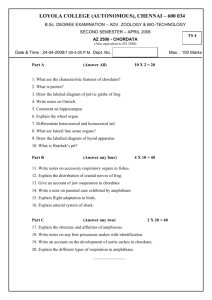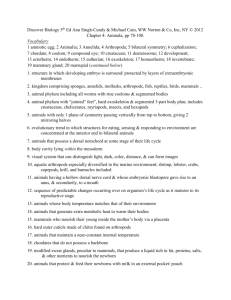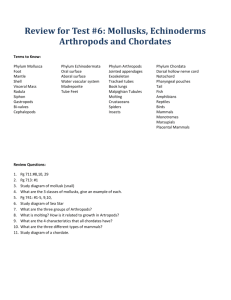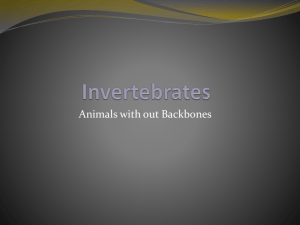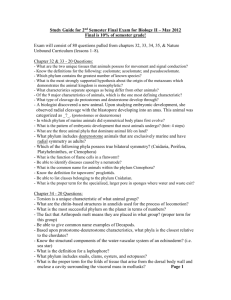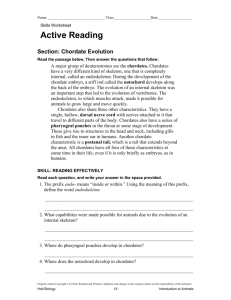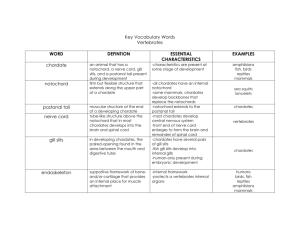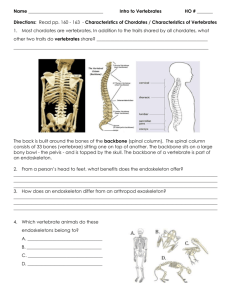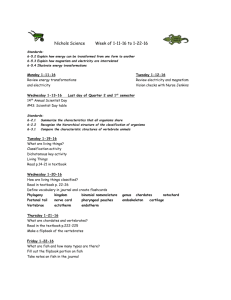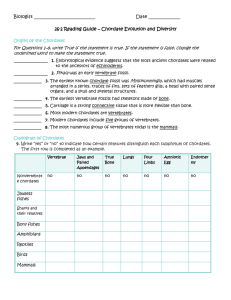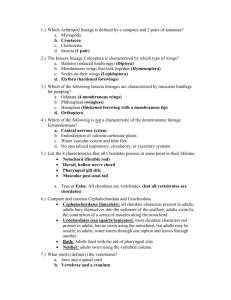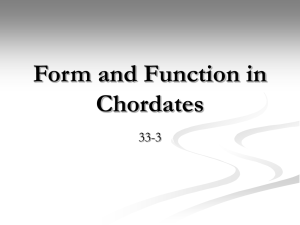Chordates Notes
advertisement
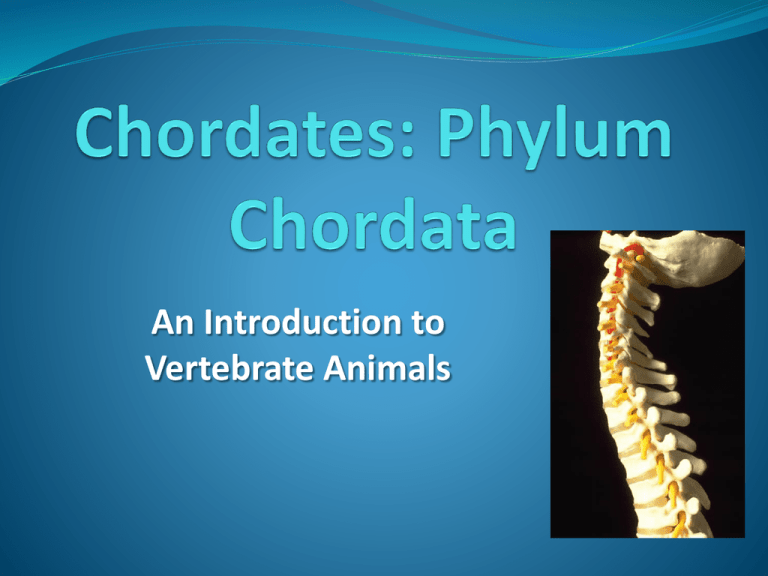
An Introduction to Vertebrate Animals Introduction Chordates (vertebrates) are the group of animals most familiar to us Ex: mammals, birds, amphibians, reptiles, fish Name comes from: Notochord “Back” “Cord” Def: a skeletal rod made of body of cells enclosed by a fibrous covering, which extends, in most cases the length of the body Primary purpose/function: to support and stiffen the body, provide muscle support In most vertebrates the notochord is displaced by vertebrae Introduction Five distinct/unique characteristics** to chordates: 1) Dorsal, tubular nerve cord (anterior end becomes enlarged to form brain) 2) Notochord 3) Pharyngeal slits /pouches (will become middle ear cavity, tonsils, parathyroid glands, etc.) 4) Endostyle (becomes thyroid gland) for filter feeders 5) Post-anal tail for propulsion (vestigial structure in humans; coccyx) ** Some of these characteristics appear ONLY in the embryonic (pre-birth) stages of vertebrates!!! Introduction Chordates have many characteristics that are similar to some invertebrate animals: 1. Bilateral symmetry (like mollusks, arthropods) Anterior to posterior axis , right/left halves 2. Coelom well developed (Tube-within-a-tube arrangement ) 3. Metamerism (segmentation) restricted to outer body wall, head and tail and not into coelom 4. Cephalization (concentrated head region) Introduction Chordates have many characteristics that are similar to some invertebrate animals: 5. Endoskeleton (some mollusks, arthropods) 6. Paired appendages (arthropods) 7. Sensory organs are highly developed (mollusks, some arthropods) 8. Three germs layers (ectoderm, mesoderm, endoderm) 9. Complete digestive system Diversity Belong to Phylum Chordata Enormous variation Live in all ecosystems on earth Most adaptable phylum on earth LARGE fossil record According to fossil record, chordates are ~500 million years old Approximately 60,000 different species Characteristics Endoskeleton: Grows as animal grows Series of vertebrae surrounding a spinal cord Skull is attached to anterior end of backbone (head-region) Functions: Protection, muscle attachment, organ attachment Characteristics Circulation: Closed system Contain arteries, vessels, veins, ventral heart Allows for rapid circulation of blood Most have separation of oxygenated and deoxygenated blood Can regulate body temperature (one of two ways) 1) Endotherms – control with internal body processes (mammals, birds) 2) Exotherms – control by outside environment (fish, amphibians, reptiles) Characteristics Endocrine system: All chordates have a thyroid gland Function: to produce hormones Nervous system: Cephalization is present Concentrated in anterior region VERY highly developed Allows for much, higher-order processes Sensory receptors highly developed (eye, nerve endings, brain processes, etc) Classification: 3 Subphyla Three subphyla: 1) Urochordata Example: sea squirt 2) Cephalochordata Examples: lanceletes 3) Vertebrata Examples: birds, mammals, reptiles, amphibians Classification Three subphyla: 1) Urochordata Known as tunicates Examples: sea squirts 2000 species Found in all seas (shoreline to great depths) Most are sessile (permanent) adults, some are free living Name tunicate comes from “tunic” This is a tough surrounding that protects animal May be solitary or live in colonies Hermaphrodites (contain both sexes) Classification Three subphyla: 2) Cephalochordata Examples: lanceletes Only 25 species Found in marine environments Sandy bottoms of coastal regions VERY small (5-7 cm in length) Free living, swimmers Separate sexes Considered the evolutionary beginning to all other chordates Classification Three subphyla: 3) Vertebrata Examples: mammals, birds, fish, amphibians, reptiles Largest and most diverse chordate subphylum ~57,000 species Found in all ecosystems, environments WIDE range of sizes Grouped together because of the skull region (bony or cartilaginous braincase) Tripartite brain (fore, mid and hindbrain) Can possess both endoskeleton AND exoskeleton
